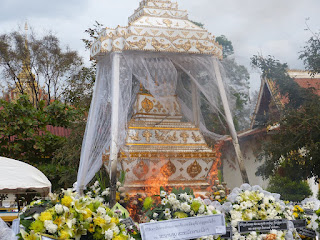 |
| This is a statue at my work, made completely out of unexploded ordinances, a major cause of death (200 annually), amputation, blindness, etc. in Laos PDR. |
Thus far, I've been using the COPE bicycle to commute to work. I figure I'm easing into the motorbike thing. The roadrules or lack there of are quite interesting. Primarily, Laos drivers don't EVER look behind them. You are responsible for the people in front of you, end of story. That may take some getting used to. Also, while they drive on the right side of the road here, it isn't uncommon for motorbikes to cruise along the left when it's convenient. In general, road rules seem lenient at best....
investing in a good helmet for sure :). And just about everyone in town rides a motorbike, young women, old women, babies, falang, monks, everyone.
 |
| This is the casket covered in an elaborate display. |
The process of saying goodbye to a loved one in the Buddhist tradition is quite complex. There are a number of rituals I didn't fully understand and many prayers spoken in Laos that I can only guess at the intentions of. The director died while away from his home, so his body was brought to the gymnasium at the National Rehabilitation Center rather than taken home. The last week has seen a continual vigilance by the deceased's family over his body, with it being essential that someone sits near the casket at all times. A number of my coworkers stayed until early morning, keeping company of the family, cooking food, and playing card games. I don't quite understand the vigilance, but I believe it has to do with the deceased's spirit which is later released when the body is burned.
 |
| The director served in the military and was well decorated, hence the uniformed pallbearers. |
This morning, the monks from the director's temple came, blessed the body, dressed the family in monk/nun robes and accompanied the procession of the body to the temple. The whole process is quite laborious due to the large amount of flowers, offerings, etc. that people have placed over the last week which accompany the body and are burned along with it, including suitcases of the director's clothing and possessions.
The family, dressed at monks and nuns, leads the casket to the temple via a long white sheet. The immense display is then re erected at the temple, followed by speeches, blessings, and finally the burning of the entire display.
 |
| The final act of the funeral, burning the body and releasing the spirit. |
Do you think it too much to ask that you have this ceremony for me? Of course I don't even know 300 people, so you might have to hire some mourners. Wine instead of beerlao Seems a shame to burn something so ornate& lovely ,but same as putting in the ground, I suppose.
ReplyDelete